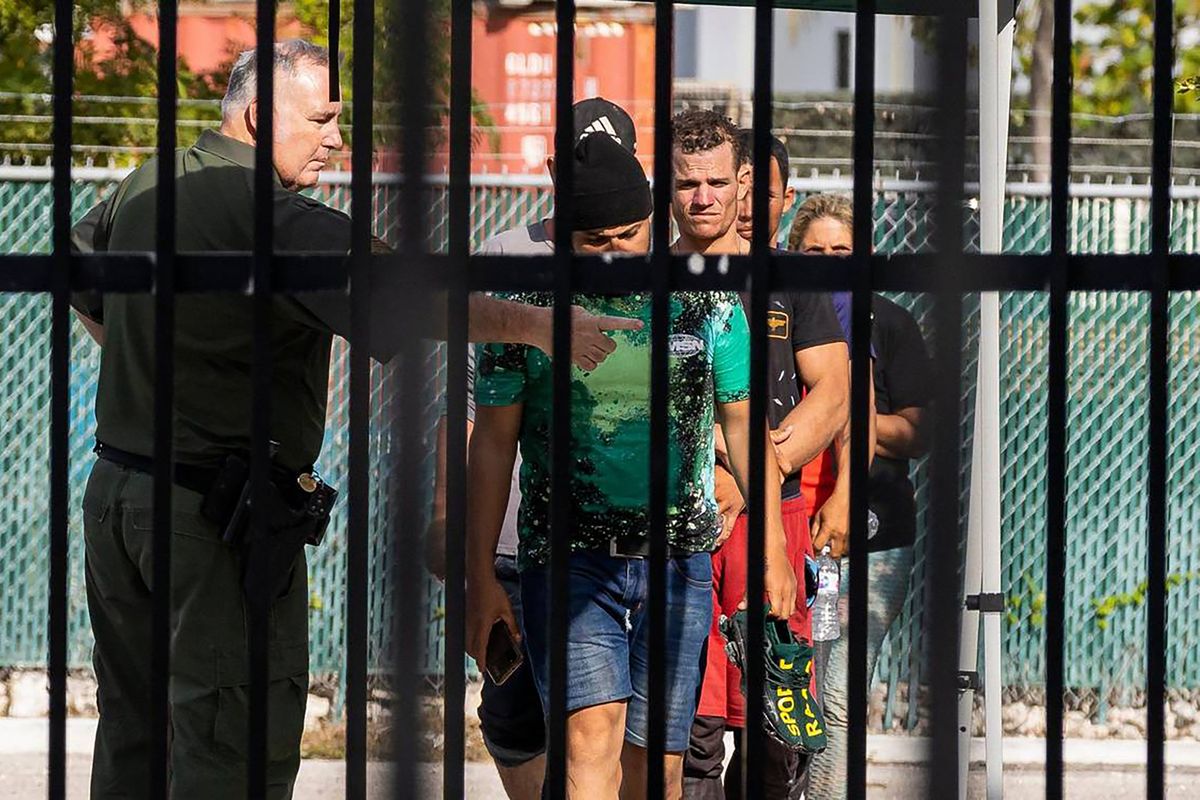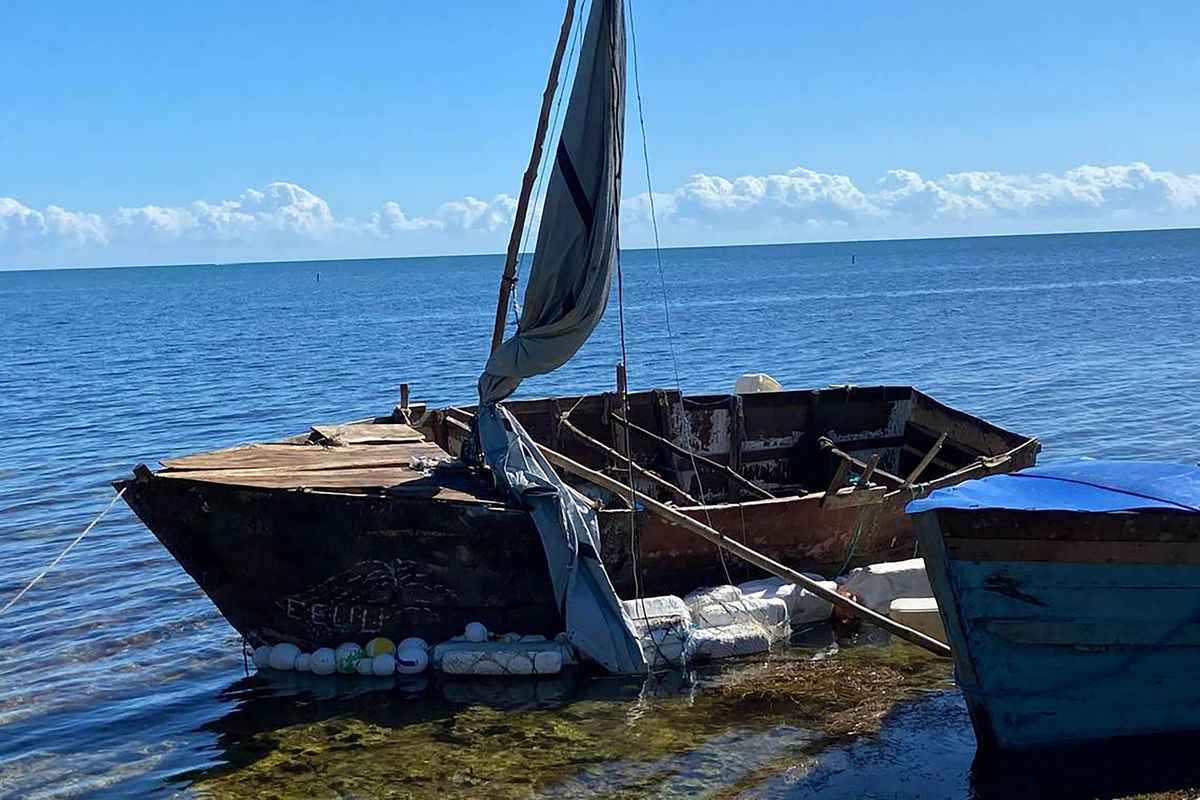As more migrant boats keep arriving, Keys responders find themselves stretched thin
A steel-hulled, makeshift migrant sailboat is grounded near the mangroves of Harry Harris Park in the Upper Keys area of Tavernier on Tuesday. (David Goodhue/Miami Herald/TNS)
MIAMI – It was early December, and Monroe County Sheriff Rick Ramsay had had it with the federal government’s response to what he considered a “humanitarian crisis” as more and more migrants arrived by boat in the Florida Keys.
“The mass migration is depleting critical staff from doing their assigned duties of protecting, responding, investigating and patrolling our communities,” he said at the time.
Every day, it seemed, more and more people, usually from Cuba and sometimes from Haiti, arrived in overloaded boats. Ramsay’s 203 road patrol deputies lacked the jurisdiction to do much more than stand on the side of U.S. 1 and wait for U.S. Border Patrol agents to arrive to shuttle the new arrivals away for processing on the mainland.
But, between receiving the “refugee arrival” calls, responding to them and then waiting around, his deputies were being pulled away from their jobs dealing with local crime.
“Each landing requires resources being diverted from other critical missions and requires sometimes many officers depending upon the number of migrants, their cooperative or less than cooperative demeanor, as well as if they are grouped together or running through citizens’ properties,” Ramsay told the Miami Herald at the time.
The sheriff complained that the migrant landings were flooding the 911 dispatch center, which then had to contact several other agencies – the U.S. Coast Guard, the Florida Fish and Wildlife Conservation Commission, fire rescue – to coordinate a response.
James Callahan, chief of Monroe County Fire Rescue, said his firefighters and medics have had to respond to several landings since the holidays. He said his department of 145 members, working at 10 stations throughout the county, has transported more than 20 migrants to area hospitals in recent weeks with various medical conditions.
The Keys has for decades been on the receiving end of migrant trips from Cuba and Haiti, but the U.S. Border Patrol reported last month that maritime migration in the region has skyrocketed since the beginning of October.
Yet at the time, the state and feds offered no relief to local agencies like the sheriff’s office.
“The government will not call this mass migration, but when migration is up to over 600% increase, we call it a mass migration,” Ramsay said.
A lot has changed in a month, starting with the way the Biden administration handles new arrivals from Cuba – from allowing those who crossed the ocean illegally to stay with a court date that could be years off, to now threatening that everyone who does so will be sent back home – a policy shift announced last week..
The next day, Gov. Ron DeSantis issued an executive order activating the Florida National Guard and tasking state agencies like the Florida Highway Patrol, the Florida Department of Law Enforcement and Florida Fish and Wildlife Conservation Commission with helping to patrol the Keys and surrounding waters for incoming migrants.
Both actions followed a steady increase in migrant landings throughout December, punctuated by a mass landing of almost 500 people from Cuba in the Dry Tortugas National Park, a group of remote islands about 70 miles west of Key West, over the New Year’s weekend.
This prompted the federal government to make the unprecedented move of closing a national park to the public for reasons other than a national disaster like a hurricane.
Ramsay said this week that so far, both the Biden and DeSantis administrations’ moves appear to be making a difference. Migrants continue to arrive almost daily, but the groups have been smaller this week, and they’re arriving less frequently.
“It’s a fluid situation that ebbs and flows. One day you may have 10 arrivals. The next day, it may be three,” Ramsay said Wednesday.
Cubans are often in contact with friends and family in the U.S. Ramsay theorizes that loved ones here are telling people on the island that “now is not the smartest time to come.”
“It’s not worth the risk right now,” he said. “And, if they come, they can’t say they didn’t know.”
Other agencies affected
The sheriff’s office isn’t the only law enforcement agency in the Keys affected by the increase in landings. Officers with smaller police departments like the city of Key West and Key Colony Beach, a tiny incorporated town in the Middle Keys, are also feeling the impact, their chiefs say.
“Officers are being called upon to handle multiple subjects that have just arrived to Key Colony Beach. The officers have other responsibilities and tasks that they need to perform during their shifts,” said the town’s police chief, Kris DiGiovanni.
Key Colony Beach has been one of the most affected areas of the Keys during the latest migrant influx, with several of the makeshift, rustic vessels arriving on the shores and oceanfront yards of the community. For his skeleton crew department – with only four full-time officers and two reserve officers – the situation has at times been chaotic, DiGiovanni said.
“After the initial landing of the migrants, the officers also will receive phone calls in reference to the vessel that is left behind,” he said. “Often if it is left at a private residence, and the homeowner is unaware of the recent landing of migrants, the homeowner might call in a suspicious vessel call and the officer will have to investigate whether or not it is the same vessel that previously arrived.”
Boats everywhere
Although the migrant situation in the Keys made national headlines over the holidays, it’s been going on for almost two years. The highest number of Cubans crossing the Florida Straits in almost a decade arrived between October 2021 and September 2022.
A byproduct of this has been a marked increase in the number of derelict boats littering the island chain, a problem made worse by Hurricane Ian in September. Brittany Burtner, the county’s senior administrator of Marine Resources, said her department removed 93 derelict vessels by the end of 2022.
It’s unknown how many more are floating in channels, canals and against the mangrove-lined shoreline, since several boats have been arriving almost every day in recent months.
“The migrant vessels have pollutants on board in the form of gasoline, diesel and oil in unapproved containers,” Burtner said. “Since there is a strain on resources, these pollutants can leak into our nearshore waters. I am concerned this can become an environmental emergency.”
Displaced and derelict vessels are documented and cataloged by the FWC. It is then up to the county to find contractors to remove the boats. The county received 150 marine removal authorizations last year, and 49 of them were migrant boats, Burtner said.
Homemade, pieced-together boats, many powered by Soviet-era truck engines in the middle of the hull, have become the unofficial symbol of the latest wave of migration to the Keys. They’re not hard to find. But, there have also been several notable arrivals of larger vessels – mostly driven by sail, all overloaded with people – from Haiti.
Two of these boats are within John Pennekamp Coral Reef State Park in Key Largo, Burtner said, and the county recently received a grant to remove them.
“In total, the county spent a little over $93,000 on vessel removals for both migrant and derelict vessels, and migrant vessels accounted for more than 67 percent of that total,” she said.
The Florida Division of Emergency Management, the agency DeSantis put in charge of the migrant operation in the Keys, released a statement on Twitter on Wednesday telling people how to report a migrant boat for removal should one arrive on their property. Under the executive order, these vessels “are not your problem,” the agency told residents.
“If an abandoned vessel lands on your property, you are not responsible for its removal,” the statement reads. “The state will remove these vessels for you free of charge.”
The agency provided a number – 888-404-3922 – to report abandoned boats.




